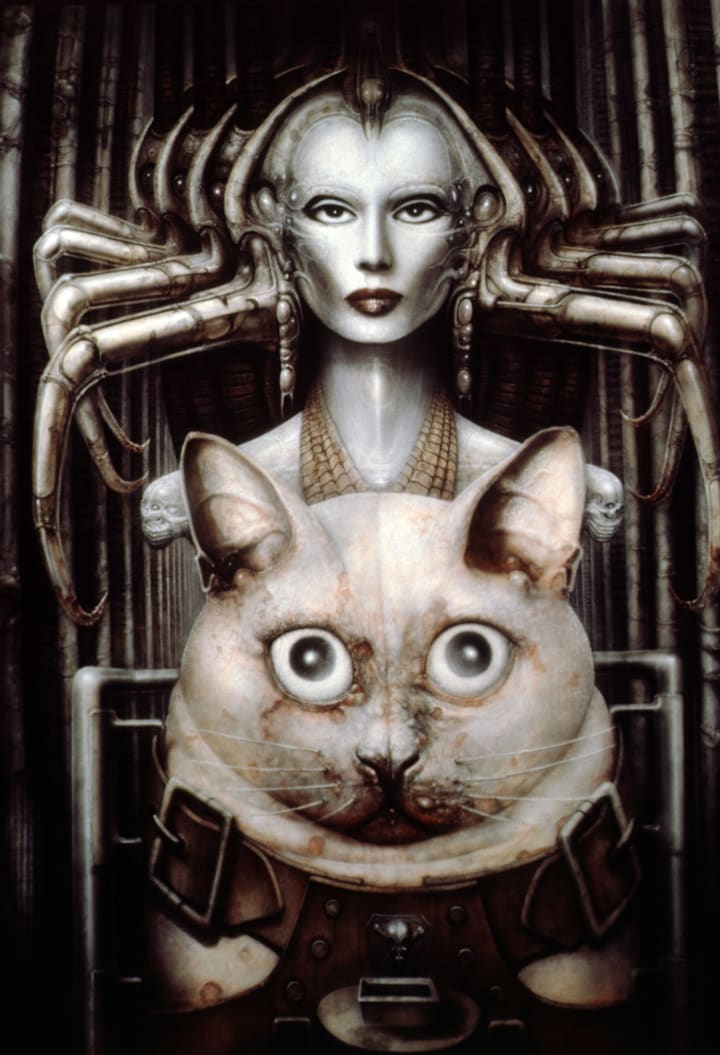Transhumanism's Sexual Identity
Transhumanism offers a new perspective on sexual attraction and sexual identity.

There are countless portals through which one can access transhumanism and sex. However, it is through Kanamara-sama Shrine that a uniquely Japanese version can be connected to the fiction style of sexpunk.
Located in modern-day Kawasaki, Kanamara-sama Shrine (lit. Metal Phallus Deity Shrine) holds an annual fertility festival, and is dedicated to sexual deities of Japan. Indeed, sex and religion are integral in the native religion of Japan, Shinto. This is clearly illustrated in Japan's creation myth, wherein the gods Izanagi and Izanami have sex, giving birth to the archipelago. Though there seem to be several legendary reasons behind the construction and devotion of Kanamara-sama Shrine, it is no surprise that another legend of sex takes center stage. Albeit, somewhat more obscure than the other tales and folkloric explanations, a summarized version goes like this:
Upon being happily married, a prince and princess consummate their wedding night. However, tragedy strikes as a demon appears from her vagina and bites off the prince's penis. The agonizing death of the prince leaves the princess saddened and without a husband. Desperate to see his daughter happily married, her father offers her hand to anyone who can defeat the demon within her. Suitors are quick to line up, and just as quickly have their members munched. It isn't until an ugly, hunchbacked blacksmith comes along with a plan that there seems to be any hope. The father agrees and the two marry, enjoying the bliss of their first night. As previously, the demon appears and chomps down on the blacksmith's penis. Fortunately, the blacksmith has cleverly forged a metal replacement, and it is this that the demon tries to bite off. Having broken all its teeth, the demon flees, and the couple lives happily ever after.
Transhumanism refers to the transformation or alteration of the flesh through genetic or material manipulation, not unlike the manipulation of the metal penis within the Kanamara origins. It is a heady topic that has spawned an array of Internet sites devoted to a variety of heavily philosophical subjects that seem to extend into the realm of science fiction. While it is true that much of the information on transhumanism concerns conjecture regarding what humanity will become, in many respects—medically, for instance—we have already begun to transform ourselves.
Though it wasn't his fortune to live for long, Mr. Craig Lewis became the first man to live without a heart or heartbeat. Other examples include the Dobelle Eye which has helped the blind "perceive" a difference between light and dark via camera-mounted glasses connected to a computer and electrodes in the brain; amputees who use prostheses; and myself, who replaced the organic lenses in my eyes with plastic nearly two decades ago to stave off potential blindness from congenital cataracts.

That stated, meeting those who've had facial transplants or printable craniums inserted is not necessarily a daily occurrence yet, unless we happen to be family members. The greater numbers of transhumans we meet are fictional: Motoko Kusanagi from Ghost In The Shell, Frankenstein's monster, Steve Austin of the Cyborg novels and Six Million Dollar Man TV series, Wolverine, the Marvel Comics superhero, Tetsuo from the Tetsuo: the Bullet Man film triptych, the telepaths of Akira and Scanners, the monstrous Engineers of Tokyo Gore Police, Kevin Flynn from Tron, and Darth Vader, among many, many others. From the far past to the far future, there are those who transform themselves through necessity or have had transformation forced upon them. No matter the story, there is always a great weight behind it, a lesson to be learned. And then there is the not so obvious: the sensuality and sexuality of the transformation.
Transformation often carries with it great power—often terrible, and yet, ultimately, desirable power. There is no greater power a human can exert over another than the invasion of the body: sex! Moreover, when you combine the transformation of the human body with lust and passion, monsters can be created—a monster like that which inhabited the princess's vagina in the opening myth of Kanamara. We read the ancient lore and think of it in mythical or ancient terms, but what if she were indeed a genetically-modified bio-gynoid from the future come to stop the line of suitors she mutilated, only to be outwitted by a clever blacksmith? And what if, in her recognition of her defeat by the man of the past, she produces offspring in a second and craftier attempt to change the past? Sounds like the lovechild of Cameron and Cronenberg.
It is within this realm of far-future body modification and adaptation, speculation and sexual adventure, that sexpunk lies. Sexpunk is battle-sex; war waged with one's genitals, wherein orgasm is the ultimate defeat. Nipples are Frankenstein's bolts with enough voltage to jumpstart rocket-cocks, and sphincters are black holes waiting to devour the very essence of any celestial body foolish enough traverse too closely. As a subgenre of fiction, sexpunk is down, dirty, and direct. It is shock-sexploitation, meant to turn the reader on with its nasty, no-punches-pulled attitude; hardcore–triple-X in nature and unapologetic. And while it carries the DNA of erotica, it doesn't rely on euphemism or prolonged scenes of sexual romance in which characters profess undying love to bring it to climax. It is the cultural acceptance of sex, monsters, and transmogrification writhing in destructive sexual prowess. Thus, while sexpunk isn't literature or art in the traditional sense of the words, it nevertheless embodies the possibilities not only to entertain, but also to comment on a wide array of social realities.
Types of Transhumanism
Transhumanism is a loosely defined cultural and intellectual movement that embraces emerging technologies to improve our lives as humans. The field of transhumanism, therefore, focuses primarily on the developing technologies themselves and their intended (or unintended) applications for humanity, as well as any possible ethical questions that these developments may create. Because these can be so broad and varied, transhumanism has branched out into many different types. These types generally account for subsets of belief systems as applied to the general concept of transhumanism as a whole. They may be ethically focused, politically focused, or technology focused. Most transhumanists find themselves aligning with more than one type of transhumanism, as they types are not necessarily mutually exclusive.
Democratic Transhumanism is a socially focused, ethically based type of transhumanism that stresses the importance of equal access to transhumanist developments and procedures to all humans. Democratic transhumanism is fundamentally based on the concept that human species, as a whole, will be elevated to greater levels of success and happiness when transhumanist concepts are applied to every one of all socioeconomic classes and levels.
Libertarian Transhumanism is similar, in that libertarian transhumanists view development and upgrade as a civil right and a civil liberty. However, it differs in that it wholly rejects government regulation as a component of the transhumanist process.
Extropianism is one of the earliest forms of transhumanism, dating back to 1988. Extropianists have an optimistic view of the future of humanity and technological development, and stress a pragmatic approach to the overall upgrade of human evolution and progress.
Singulatarianists believe that the move to a transhumanist future will occur by way of a single event in the near-medium future that is facilitated by a super intelligent machine that may or may not be acting in humanity’s best interest. Singulatarianism focuses on putting as much effort as possible into managing this event so that it plays out in the best way it can for all of humanity.
The Hedonistic Imperative is a type of transhumanism that focuses on the improvement of the human psychological state through drugs and gene evolution. It believes that typical human experiences that are challenging (pain, anxiety, stress) are ultimately unnecessary and outdated reactions in the brain which have served to protect us in the past but are now effectively obsolete.

Survivalist Transhumanism focuses on aging and death. This is one of the most popular types of transhumanism. A survivalist transhumanist views death and the first and foremost component of human life to be conquered by upgrading our human condition.
Religious Transhumanism is a body of transhumanists that view the movement as being compatible with their existing religious beliefs. The greater bulk of people who view themselves as transhumanists are atheistic, but there are significant organized bodies such as the Mormon Transhumanist Association, as well as the Christian Transhumanist Association, which believe otherwise.
Cosmopolitan Transhumanism views humans as citizens of the cosmos, rather than any particular town, city, or country. As transhumanism is the philosophy of how we can use technology to evolve the human species in an ethical manner, the two belief systems fit together quite nicely. The primary tenets of cosmopolitan transhumanism state that in order for transhumanism to be most beneficial to humanity as a whole, we must cast off our nationalistic, geopolitical, and patriotic allegiances in favor of our overall unity as a species.
Cosmism is a very open and accepting form of the transhumanist philosophy that does not limit inclusion to any particular beliefs about the nature of the universe, the nature of humanity, or how, when, and why we will be best served by our adoption of transhumanist focused developments. The cosmism philosophy believes that science may well turn out to be far more limited than we have been led to believe. It expresses the belief that science, similarly to religion or philosophy, may not be enough to accomplish the wholly gargantuan task of understanding life and our universe. In accepting this possibility, it also teaches that active engagement in the world and reflection on what we learn and what we have created, is the only way for humans as a species to get to the next stage of collective thinking and understanding.
Anarcho-Transhumanism is the adoption of the transhumanist philosophies from the perspective of modern Anarchism. Which is to say that it is anti-capitalist and anti-state while still valuing democratic ideals such as consensus building and acting in one’s own interest. The Anarcho-transhumanist believes that transhumanist developments (such as networked brain communication) will bring tools that can better facilitate these forms of democracy and thereby make a government state entirely unnecessary.
While this list of types of transhumanism is pretty extensive, it is far from exhaustive. As you can see, there is a lot of overlap in the beliefs from one type to another, and again, it is not unusual for a transhumanist to find themselves aligning with several different types of the overall philosophy. To understand more about transhumanism as a whole and how its ideas impact society, read David Livingstone's cautionary book, Transhumanism: The History of a Dangerous Idea.
Written by David Livingstone, Transhumanism: The History of a Dangerous Idea, gives an in-depth look at transhumanism, a popular science fiction genre. The book tells a cautionary tale, detailing the roots of the transhumanist movement and its ties to the desire to perfect the human form. Livingstone discusses the dangers of what transhumanists believe to be the "inevitable merger" of Man and Machine and the ascendancy of the Cyborg.
About the Creator
Made in DNA
The not-yet bestselling, non-award winning author of work you haven't read yet!
Work spans various genres -- scifi, weird, non-fiction, life in Japan.
Campsite Bio (website, Twitter, FB, IG, Mastodon, etc.)
Enjoyed the story? Support the Creator.
Subscribe for free to receive all their stories in your feed. You could also pledge your support or give them a one-off tip, letting them know you appreciate their work.
Reader insights
Nice work
Very well written. Keep up the good work!
Top insight
Eye opening
Niche topic & fresh perspectives







Comments
There are no comments for this story
Be the first to respond and start the conversation.